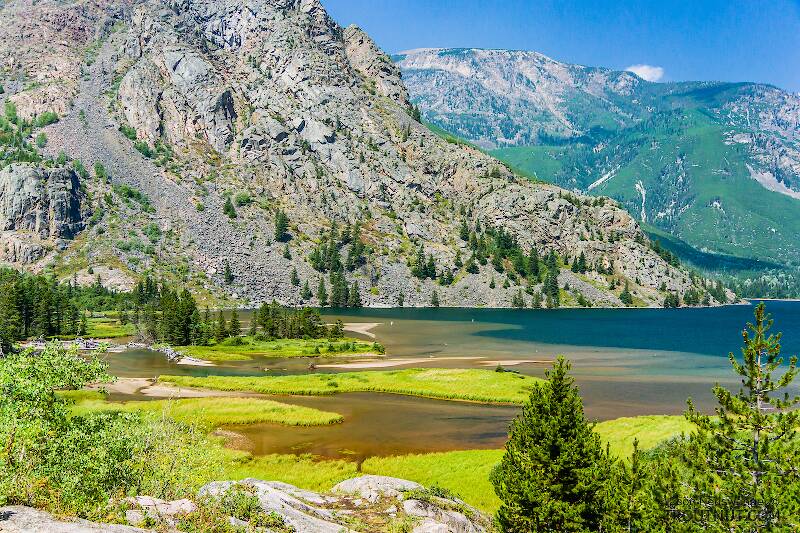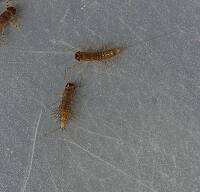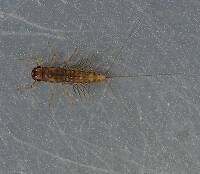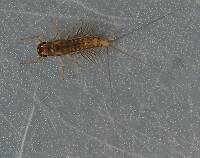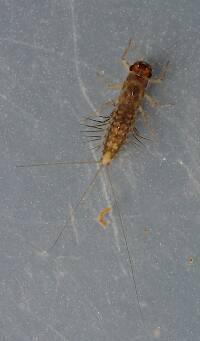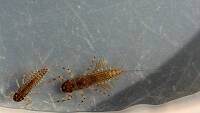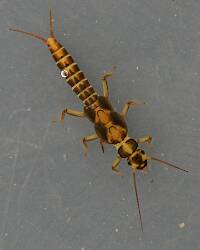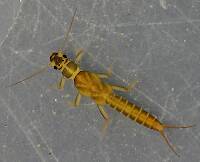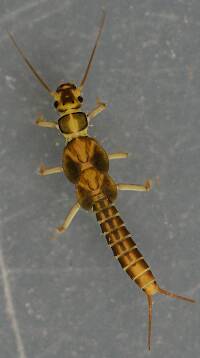
Blue-winged Olives
Baetis
Tiny Baetis mayflies are perhaps the most commonly encountered and imitated by anglers on all American trout streams due to their great abundance, widespread distribution, and trout-friendly emergence habits.
Featured on the forum

This specimen keys to the Epeorus albertae group of species. Of the five species in that group, the two known in Washington state are Epeorus albertae and Epeorus dulciana. Of the two, albertae has been collected in vastly more locations in Washington than dulciana, suggesting it is far more common. On that basis alone I'm tentatively putting this nymph in albertae, with the large caveat that there's no real information to rule out dulciana.

Troutnut is a project started in 2003 by salmonid ecologist Jason "Troutnut" Neuswanger to help anglers and
fly tyers unabashedly embrace the entomological side of the sport. Learn more about Troutnut or
support the project for an enhanced experience here.
GoofusBug
Posts: 31
Posts: 31
GoofusBug on Jan 8, 2009January 8th, 2009, 9:38 am EST
When you first approach a stream, what's your strategy?
Do you spend much time looking to see what kind of insects are in the air?
Do you look for feeding fish?
Do you start with a particular pattern each time?
What's your strategy?
Do you spend much time looking to see what kind of insects are in the air?
Do you look for feeding fish?
Do you start with a particular pattern each time?
What's your strategy?
RleeP on Jan 8, 2009January 8th, 2009, 12:03 pm EST
The first thing I do is consider water level and clarity. If it is during the period between say, 5/1 and 10/1, these two things will have the most influence on what fly I start with. Before 5/1 and after 10/1, I usually also take a water temp before I begin fishing.
I spend essentially zero time looking for bugs. If there is a relationship on that particular day between insects and the fish that can benefit me and my success, it will become apparent to me as I go along and I'll address it then. But I'm hasty by nature and the first thing I want to do when I get there is rig up and start waving my stick in the air.
So far as what fly I start with, that too varies by time of year and water temp, as well as the stream I'm on. If the water is under 48F and there are no bugs in evidence on the water, I'll usually fish a pair of nymphs, the size of which will vary depending upon water level and clarity. One will usually be a PT of some sort and the other a Prince, an Upper Midwest regional pattern called a Pink Squirrel (in less clear water) or a hare's ear. But if the water is clear, the 2nd fly will usually be a small olive nymph, like an #18.
If the water is above 48 and fairly clear, I'll fish on top. Early in the season, I'll go with something the fish are likely to recognize like a #16 Grannom caddis or a #18 BWO, usually a parachute. In May, if there are no bugs, I almost always start with a #16 Hares Ear Parachute. It's murder on the fish in the Midwest Spring Creeks. After about 6/15 and until the autumn olives become common, I almost always start with a #10 deerhair ant.
But regardless of the time of year or weather, I seldom spend much time taking in the situation when I first arrive. Later maybe.. I'm fishing ASAP. I've been that way since I was 3 years old and Dwight Eisenhower was in his first term..
I spend essentially zero time looking for bugs. If there is a relationship on that particular day between insects and the fish that can benefit me and my success, it will become apparent to me as I go along and I'll address it then. But I'm hasty by nature and the first thing I want to do when I get there is rig up and start waving my stick in the air.
So far as what fly I start with, that too varies by time of year and water temp, as well as the stream I'm on. If the water is under 48F and there are no bugs in evidence on the water, I'll usually fish a pair of nymphs, the size of which will vary depending upon water level and clarity. One will usually be a PT of some sort and the other a Prince, an Upper Midwest regional pattern called a Pink Squirrel (in less clear water) or a hare's ear. But if the water is clear, the 2nd fly will usually be a small olive nymph, like an #18.
If the water is above 48 and fairly clear, I'll fish on top. Early in the season, I'll go with something the fish are likely to recognize like a #16 Grannom caddis or a #18 BWO, usually a parachute. In May, if there are no bugs, I almost always start with a #16 Hares Ear Parachute. It's murder on the fish in the Midwest Spring Creeks. After about 6/15 and until the autumn olives become common, I almost always start with a #10 deerhair ant.
But regardless of the time of year or weather, I seldom spend much time taking in the situation when I first arrive. Later maybe.. I'm fishing ASAP. I've been that way since I was 3 years old and Dwight Eisenhower was in his first term..
SlateDrake9 on Jan 8, 2009January 8th, 2009, 12:16 pm EST
It depends.
On streams that I have to compete with other anglers for a spot to fish, I hurry up and get myself to the section I want to fish and then watch.
On streams that I don't have to worry about other anglers, I take my time. I slowly walk to the stream, but still stop and watch for a while.
What I am looking for is fish activity and secondly insect activity. For me, where the fish are and their activity is way more important than what insects are around. I'm familiar enough with the waters I fish to know what insects to fish/flies to throw.
On streams that I have to compete with other anglers for a spot to fish, I hurry up and get myself to the section I want to fish and then watch.
On streams that I don't have to worry about other anglers, I take my time. I slowly walk to the stream, but still stop and watch for a while.
What I am looking for is fish activity and secondly insect activity. For me, where the fish are and their activity is way more important than what insects are around. I'm familiar enough with the waters I fish to know what insects to fish/flies to throw.
Fishing with bait is like swearing in church.
-- Slate Drake
-- Slate Drake
Hellgramite on Jan 8, 2009January 8th, 2009, 3:02 pm EST
If I have my dog with me I look to see where the fish scatter to after he runs up to the water.If my dog is not with me I slowly approach the water making sure My approach is from down stream.This way i come in behind the fish.If there is a tree I slowly crouch behind the tree and scan the water to see if there any fish in the feeding zone.If not I sometimes crawl in and look over the edge and look along the under cuts.I make sure not to step to hard as to create any vibration on the ground.Plus I ware camo or earth tone shirt to blend in.Several times I have been able to get within feet of a fish.In fact sometimes this is almost as fun a catching one.Unless there is a hatch going on I always start with a nymph.In fact I fish nymphs 90% of the time.And that is my story.
Wetfly1 on Jan 9, 2009January 9th, 2009, 2:21 am EST
For me it depends on the water conditions and the time of the year. All the streams I fish, I know when specific hatches will occur. But if no flys are present I will start with 3 of my favorite wet flies that have produced fish on that stream before. If I see later that flys are hatching I'll switch to 3 different wets that match the flies. I also try to locate a stretch of water that isn't being fished,but fishing in PA in the early and mid part of the season that's pretty hard to come by. But if I have company I'll put some distance between myself and the other angler. And if I am picking up fish in that stretch of water I'll fish it through a couple of times.
Ddotson on Jan 9, 2009January 9th, 2009, 10:55 am EST
I approach the stream as softly and as low as possible. I am 6'4" and am followed around by a large shadow...
When entering the water, and if fish are visible, I approach them from behind and watch their activity for a few to see how they are feeding, from there my fly choice is made.
If I have never fished a stream, I tend to flip over a few rocks, if available, to see what I can see. In addition, if fish are not in view, I use a nymph, merger dropper pattern in edge of and through ripples, if available..
When entering the water, and if fish are visible, I approach them from behind and watch their activity for a few to see how they are feeding, from there my fly choice is made.
If I have never fished a stream, I tend to flip over a few rocks, if available, to see what I can see. In addition, if fish are not in view, I use a nymph, merger dropper pattern in edge of and through ripples, if available..
fly fishing brings normal people to beautiful places
Trtklr on Jan 11, 2009January 11th, 2009, 4:51 am EST
two years ago I walked up on a creek and spooked an entire school of brook trout rising to a hatch. i doubled back and waited for a few and crawled up to the creek.i was able to catch one. now I always look at the surface well before I get close and try an approach from downstream of where I want to start.
I have seen nothing more beautiful than the sunrise on a cold stream.
Hellgramite on Jan 11, 2009January 11th, 2009, 9:04 am EST
I have found that if you come up on and spook the fish.Watch where they go.And if you take the time to just sit for a few with out making any fast moves they well slowly move back out.This is why in a past post I talked about camo or earth toned clothing.
Leakywaders on Jan 11, 2009January 11th, 2009, 5:20 pm EST
If I was a helgramite, I'd wear camo too.
I look first for rises, without reveiling myself.
If there are none, it depends on the last time I was there.
On new water, or if I have not been there latley, I always start out using the screen to find out what is growing in the rocks, riffels, and mud. If I manage to do that without falling in, I rig my rod, and put something on to match whatever I found in the screen.
I look first for rises, without reveiling myself.
If there are none, it depends on the last time I was there.
On new water, or if I have not been there latley, I always start out using the screen to find out what is growing in the rocks, riffels, and mud. If I manage to do that without falling in, I rig my rod, and put something on to match whatever I found in the screen.
Drag free??? If the fly didn't drag, I wouldn't know where it was!!
Hellgramite on Jan 12, 2009January 12th, 2009, 6:04 am EST
Hellgramites camo?Anyway What I have found is if you fish water that gets hammered allot the fish become vary selective as far as size and color.So yes I spend time looking to see whats in the water as far as bugs go.If you are able to hike away from where there are allot of people, or fish water where people are not,I have found the fish well hit the kitchen sink.A guide told me along time ago that if you can catch fish on water where people tend to stack up because its an easy place or a place that is known for great fishing.You can catch fish any where.I guess what I'm trying to say is if you can fish less fished water the fly you use yet important becomes less important.
Shawnny3 on Jan 15, 2009January 15th, 2009, 1:03 am EST
Even though few people are disciplined enough to do it, I've found that seining can be pretty important at times. Even if there's no obvious hatch going on, if it's a time of year for hatching bugs, I seine first unless I'm in a big hurry.
On new streams, if I have the time, I'll spend a good hour kicking up rocks and dirt in all types of water, just to get familiar with the bugs the stream has.
But on a stream I'm familiar with, I don't bother with that. Last year I started what I'll call "natural" seining, which basically means I seine without kicking stones around. I simply stand in the current, hold the seine in one spot for about ten seconds, and then lift it out and see what I've caught. Then I'll move to a different type of water and repeat. You might be as amazed as I was at how many bugs you can catch this way during a good time for hatches.
The advantages to this type of seining are many. First, I only catch bugs that are actually in the current at the time I'll be fishing. I also get some sense as to the relative frequency in the current of each type of bug. If I keep the top of my seine just out of the water, I catch emergers, duns, and spinners in addition to nymphs. I see bugs that are small enough that I might not have noticed their prolificness otherwise. I catch the empty skins of nymphs that have already hatched. I get to inspect up close the subtle size and color variations in the insects the fish are seeing. Best of all, it doesn't take long. If there are hatching insects of consequence, I'll find out within two minutes. Not only does that change my fly selection, but it also impacts which types of lies I will fish and how I will fish them. So even if nothing much is going on, I'll still have gained valuable information as I tie on my standard rig and begin fishing.
This style of seining has changed the way I approach the stream and gives me great confidence when I tie on that first fly and make that first cast. And every fisherman knows that self-confidence is a critical factor in catching fish, especially when that confidence is actually grounded in reality.
-Shawn
On new streams, if I have the time, I'll spend a good hour kicking up rocks and dirt in all types of water, just to get familiar with the bugs the stream has.
But on a stream I'm familiar with, I don't bother with that. Last year I started what I'll call "natural" seining, which basically means I seine without kicking stones around. I simply stand in the current, hold the seine in one spot for about ten seconds, and then lift it out and see what I've caught. Then I'll move to a different type of water and repeat. You might be as amazed as I was at how many bugs you can catch this way during a good time for hatches.
The advantages to this type of seining are many. First, I only catch bugs that are actually in the current at the time I'll be fishing. I also get some sense as to the relative frequency in the current of each type of bug. If I keep the top of my seine just out of the water, I catch emergers, duns, and spinners in addition to nymphs. I see bugs that are small enough that I might not have noticed their prolificness otherwise. I catch the empty skins of nymphs that have already hatched. I get to inspect up close the subtle size and color variations in the insects the fish are seeing. Best of all, it doesn't take long. If there are hatching insects of consequence, I'll find out within two minutes. Not only does that change my fly selection, but it also impacts which types of lies I will fish and how I will fish them. So even if nothing much is going on, I'll still have gained valuable information as I tie on my standard rig and begin fishing.
This style of seining has changed the way I approach the stream and gives me great confidence when I tie on that first fly and make that first cast. And every fisherman knows that self-confidence is a critical factor in catching fish, especially when that confidence is actually grounded in reality.
-Shawn
Jewelry-Quality Artistic Salmon Flies, by Shawn Davis
www.davisflydesigns.com
www.davisflydesigns.com
Trtklr on Jan 15, 2009January 15th, 2009, 2:58 am EST
very well put Shawnny, that class is the right thing to do. if you sample different spots(riffles,runs,pools) of the rivers at different times of the year the knowledge will last a life time for better fishing. i've felt the absence of a hatch is when i want my seine the most. it makes me think about the abundance of life in and around cold moving water. it attracts life like nothing else i know.
all there is in january is ideology of the stream for me, well at least when its -5 out.
the steelhead are coming!
all there is in january is ideology of the stream for me, well at least when its -5 out.
the steelhead are coming!
I have seen nothing more beautiful than the sunrise on a cold stream.
Quick Reply
Related Discussions
Topic
Replies
Last Reply
I agree with the nymph and emergence coments above
In the Mayfly Species Litobrancha recurvata by Beardius
In the Mayfly Species Litobrancha recurvata by Beardius
0
Aug 1, 2008
by Beardius
by Beardius
3
Sep 14, 2010
by Jmd123
by Jmd123

